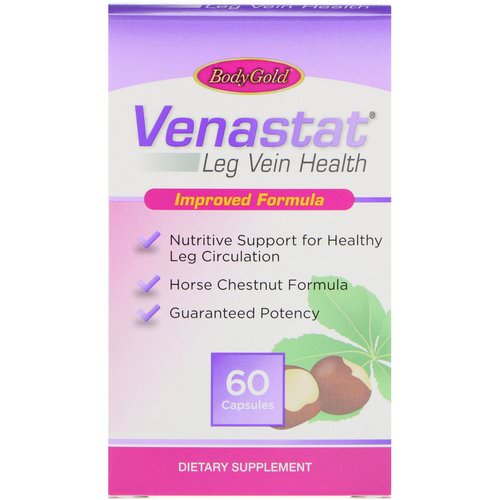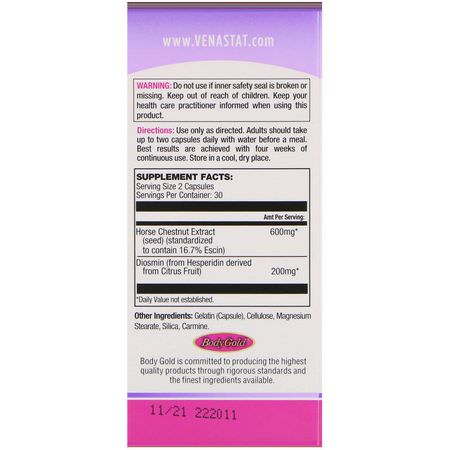Foodpharmacy Blog: Homeopathy, Herbs, Horse Chestnut
BodyGold, Venastat Leg Vein Health, 60 Capsules

$5.90
Product name: BodyGold, Venastat Leg Vein Health, 60 Capsules
Quantity: 60 Count, 0.07 kg, 11.4 x 7.1 x 5.3 cm
Categories: BodyGold, Herbs, Homeopathy, Horse Chestnut
Nutritive Support for Healthy Leg Circulation, Horse Chestnut Formula, Guaranteed Potency, Dietary Supplement, What is Venastat? The Venastat formula is a natural supplement that is intended to provide nutritive support for tired legs and leg vein health and circulation, What makes Venastat special? Venastat’s HC167 Horse Chestnut extract is standardized to 16.7% Escin to provide a consistent level of extract in every easy-to-swallow capsule. This is a level of standardization used in several clinical studies, How does Venastat work? The extract in Venastat is intended to provide nutritive support for healthy circulation. Diosmin is a bioflavonoid and is intended to provide nutritive support for healthy veins, circulation and lymphatic flow, Why take Venastat? For many people, achy, tired or swollen legs are an unnecessary part of their daily lives. Standing or sitting for long periods or even natural aging can make it more difficult for your body to efficiently circulate blood from your legs to your heart. Fluid can collect in the legs and pass from the capillaries into the surrounding tissues. As a result, your legs can feel achy, heavy or tired, BodyGold, Body Gold is committed to producing the highest quality products through rigorous standards and the finest.

Studies support the potential of horse chestnut extract, and it appears to be safe and effective when used properly. Horse-chestnuts have been affected by the leaf-mining moth cameraria ohridella, whose larvae feed on horse chestnut leaves. I have taken the horse chestnut (Varied brands) or venastat for several years and i do not get the cramping in my legs like i once did. These oils are often used for alternative therapies. In-depth information about the traditional uses of this herb can be found in our herbs a-z section. In herbal and folk medicine, horse chestnut seed, leaves, bark, and flowers have long been used to relieve symptoms, such as swelling and inflammation and to strengthen blood vessel walls. Nature’s way standardized horse chestnut is produced according to the best practices for gmo avoidance. The roles of butcher’s broom (Ruscus aculeatus), horse chestnut (Aesculus hippocastanum), stone root (Collinsonia canadensis), witch hazel (Hammamelis virginiana), arnica (Arnica spp), oak (Quercus spp), chamomile (Matricaria recutita), gotu kola (Centella asiatica), calendula (Calendula officinalis), and psyllium (Plantago ovata) in hemorrhoid treatment are discussed. In general, therapeutic doses should be adhered to, and herbal teas should not be used excessively.
BodyGold, Venastat Leg Vein Health, 60 Capsules: Horse Chestnut, Homeopathy, Herbs
Two incidences of toxic nephropathy have been reported and were stated as probably secondary to the ingestion of high doses of aescin, 48 the main saponin component of horse chestnut. Keep all medicines out of the reach of children. Research suggests that horse chestnut seed extract may be useful in treating cvi. Historically, horse chestnut seed extract has been used for a variety of health conditions, including joint pain, gastrointestinal issues, fever, and leg cramps. In addition, horse chestnut helps maintain water balance and supports normal leg size. Investigations in animal models suggest that horse chestnut seed extract, in particular, may have anti oedematous, venotonic, and anti-inflammatory properties. Aescin (Escin), a triterpenoid isolated from horse chestnut, helps to inhibit these damaging enzymes, increases the tone of the veins and improves return blood flow to the heart.

Used in herbal medicine to help slow the progression of disorders of the eye, such as diabetic and hypertensive retinopathy, and macular degeneration. Horse chestnut is traditionally used in herbal medicine to help treat haemorrhoids; used in herbal medicine to help treat chronic venous insufficiency and associated symptoms and varicose veins. Overall, the trials suggested an improvement in the symptoms of leg pain, oedema and pruritus with horse chestnut seed extract when taken as capsules over two to 16 weeks. Tru-id is an independent testing program that uses cutting-edge dna biotechnology to ensure the authenticity of our herbal products. Note: Pregnant or nursing women should not use horse chestnut seeds. For more information about potential side effects of this herb please visit our herbs a-z section. In japan, where horse chestnut has been used as an antiinflammatory drug after surgery or trauma, hepatic injury has been described in a male patient who received an intramuscular injection of a proprietary product containing horse chestnut.
Because horse chestnut can lower blood sugar, use it with caution if you have diabetes and are taking drugs to lower blood sugar (Watch for signs of low blood sugar and monitor your blood sugar carefully). The medicinal properties of the horse chestnut are attributed mainly to a group of saponins called aescin. I have been using the now brand horse chestnut (Also includes rutin) for a while with relatively good success at managing a minor, but painful varicocele near my left testicle. Short-term studies have shown the efficacy of horse chestnut seed (Aesculus hippocastanum ) extract in reducing edema, ankle and calf circumference, and symptoms of vvs with insufficiency. In the placebo-controlled studies, researchers found that horse chestnut did reduce symptoms, such as leg pain and swelling. Continue reading to find out the science behind the horse chestnut. Is a herbal remedy used for venous insufficiency. Quercetin 3,4′-Diglucoside, a flavonol glycoside can also be found in horse chestnut seeds. That is why, generally speaking, herbs are much safer and easier on the body than most prescription drugs. Crude herbal preparations contain toxins (Typically fine topically).
Unfortunately, when ingested raw in an unprocessed form, the bioactive compounds in the horse chestnut may cause unwanted side effects such as severe gastroenteritis, also known as the stomach flu, an intestinal infection marked by diarrhea, cramps, nausea, vomiting, and fever. When eaten in it’s raw, unprocessed form, horse chestnut is toxic to humans and most animals. Do not use unprocessed raw horse chestnut preparations, as they can be toxic and lethal when ingested, as indicated above. With thousands of years behind them, it’s no wonder that herbs have even earned such a respected place in the world of medicine – even in modern medicine. Herbals and herbal products, at least those of unknown dosage and contamination, should be used with caution and obtained from a reliable source. The doses of active principles in homeopathy, however, are minute. Those considering alternative treatments should also understand proper dosage recommendations, risks, and side effects.
BodyGold Horse Chestnut
Aescin is the major active principle from the horse chestnut tree and is claimed to have clinical activity in venous insufficiency. Aesculus hippocastanum is the botanical name for the horse chestnut tree, or sometimes, simply the aesculus tree. When it comes to supporting healthy blood circulation throughout the body, research suggests that horse chestnut seed extract supplementation may have a positive effect on not only the health of the veins in the arms and legs, but also blood circulation through the ears, skin, heart, and lower bowels. The horse chestnut is a medicinal plant that has been in use in europe for many years. 7, Horse chestnut seeds horse chestnut seeds have been used for ages in the treatment of varicose veins. Usable parts of the horse chestnut tree for medical formulations include it’s seed, bark, and leaves. Therefore, researchers look for traditional medicines as a potential resource for introduction of new natural drugs. This cd-rom, produced in germany by a consultancy specializing in herbal remedies, is a rather nattily designed library of herbal medicines, encompassing folk, herbal (Western, indian and chinese) and homeopathic medicine.
The bioactive compounds in horse chestnut seed extracts are poorly absorbed in the digestive tract, which means that they are flushed out through the kidney and gallbladder, causing much strain on the organs. One small study showed that horse chestnut extract providing 120 mg of horse chestnut seed extract per day significantly improved symptoms of pain, itching, burning, and swelling. While horse chestnut extract is not regulated in the u. Be sure to work with your doctor to find which herbs and supplements may be right for you. A comprehensive treatment plan for varicose veins may include several complementary and alternative therapies (Cam). Smelling lavender has been shown to help reduce pain, according to the journal evidence-based complementary and alternative medicine. You will, however, find horse chestnut as an ingredient in a variety of dietary supplements, including capsules, tablets, liquid extracts, and tinctures, as well as topical ointments, and more. Horse chestnut cream by planetary herbals really does help swelling in my legs and ankles. Lead in ayurvedic medicine or traditional chinese herbs) has been observed (See chapter 4,18). Not all herbs are suitable in pregnancy, breastfeeding or for young children, or if you are unwell, have health concerns or an ongoing illness. There is no systematic study of homeopathy as it relates to lactation. Ehrlich, nmd, solutions acupuncture, a private practice specializing in complementary and alternative medicine, phoenix, az. Gluten-free and vegetarian: Standardized horse chestnut is gluten free and vegetarian.
For those wishing to study herbal medicine in more depth, this program is a useful addition to the usual textbooks, with the most useful feature being the easy cross-referencing. Publish the definitive text of naturopathic medicine for urologic and male reproductive health conditions. I’ve had to have a lot of ivs and blood tests over the last few years and horse chestnut cream by planetary herbals has helped my veins heal from so much trauma. They may also be used in food, food supplements, cosmetics and as a starter ingredient by herbalists in prescription formulas. I do not know that the brand particularly matters all that much but i definitely find horse chestnut to be a valued addition to my meds regimen. In herbal formulations, it goes through an extraction process and is standardized for use in various dietary supplements designed to support healthy veins, joints, muscles, and skin. She was told she needed horse chestnut for life and we ordered this for her once and she says they have helped so much and have made a great difference. I generally recommend horse chestnut seed extract (Hcse) for treatment of varicose veins. People, who suffer from hemorrhoids, tries variety of self treatment methods such as utilizing animal products and homemade herbal preparations. If in doubt, please ask us or your medical herbalist. It can be taken internally as a standardized extract or in relatively large doses of the crude herb, and it can be applied topically solo or mixed with high-tannin herbs.
That it is absorbed by the skin and an alternative for those who are allergic to the horse chestnut herb or cannot take it in capsule form. With tru-id validation, you can be sure that the standardized horse chestnut featured on our label matches what is in our product. Horse chestnut cream 2 oz (56,7 Grams) from planetary herbals contains other potent ingredients too that provide tonifying benefits. Although eating raw horse chestnut is now understood to be a dangerous and possibly fatal mistake by humans, research indicates that historical uses included grinding up the fruit and feeding it to horses to relieve cough symptoms. The herb is steeped in a mixture of alcohol and water for a period of time before pressing. All herbs used in abdominal pain), or by a choice of pharmacopoeias including the british herbal pharmacopoeia. General contains an introductory paragraph with a short account of it’s history, use in contemporary folk medicine, and the parts of the plant in medicinal use.
At it’s worst, ingesting unprocessed horse chestnut plant parts could also cause paralysis or coma.